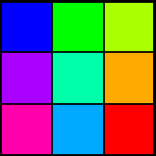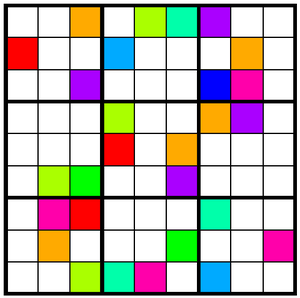November 26, 2006
Color sudoku
 Here is a little demonstration of how our affordances can make formally identical tasks differently hard.
Here is a little demonstration of how our affordances can make formally identical tasks differently hard.
I took a sudoku puzzle from Daily SuDoku and replaced the numbers with colors. It works just as normal, you have to fill in the colors so that each color occurs within each 3x3 matrix and along each row and column of the larger square. The simplest way of trying it may be to download the picture into a paint program and use the fill tool.
Easy, isn't it?
Colors do not have a discrete representation in our visual system unless occuring in a small simple set such as red-green-yellow-blue. Hence our ability to easily recognize whether there is a duplication or a gap in a color set that doesn't fit in with this will be impaired. While numbers are easily handled as discrete objects, perhaps through a spatial or verbal representation. Several sites have sudoku puzzles that show numbers with colors, which presumably makes things easier by enabling different minds to use whatever strategies fit them.
There is a color sudoku game out there, but it seems to start with colors selected for maximal discreteness (my set is equidistant by 40 degrees along the color circle instead).
The Flickr sudoku game seems to bear this out. Here the elements are images, again with no easy set membership detection. Of course, having to do saccades all the time to the list slows things down too.
Posted by Anders3 at November 26, 2006 05:09 PM